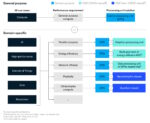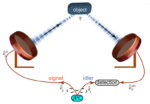The Open Domain-Specific Architecture (ODSA) is a project within the Open Compute Project (OCP) community to establish open physical and logical die-to-die (D2D) interfaces for chiplets. The goal is to democratize the design and use of chiplets for domain-specific high-performance computing (HPC) applications like generative artificial intelligence (AI). Domain-specific architectures (DSAs) are an emerging approach […]
How do heterogeneous integration and chiplets support generative AI?
Chiplets are here, and more are coming. They can overcome the yield limitations of large ASICs, support a mix-and-match strategy for heterogeneous semiconductor IPs and multiple process nodes, improve thermal performance, and speed time to market. They are being used in a range of high-performance computing (HPC) applications, notably generative artificial intelligence (AI) and machine […]
What quantum sensors can be used as GPS replacements?
There’s a variety of quantum sensors available for use as a global positioning system (GPS) replacement including quantum compasses, atomic gyroscopes, and atom interferometers. Several options for a quantum GPS replacement, also called quantum position sensing (QPS), are being developed. Three examples include quantum active navigation that overlays and supplements existing satellite-based GPS systems, quantum […]
Securing devices for the IoT – IEC 62443, SESIP, and PSA
The International Electrotechnical Commission (IEC) 62443 series of standards is focused on security for Industrial Automation and Control Systems (IACS); the Security Evaluation Standard for IoT Platforms (SESIP) provides a method for trustworthy assessment of the security IoT platforms, including the industrial IoT (IIoT), and Platform Security Architecture (PSA) certification requires strict adherence to the […]
Securing devices for the IoT — managing memory
Memory management is important in all digital electronic devices including devices designed for use on the Internet of Things (IoT). It supports efficient resource allocation and memory utilization and prevents memory fragmentation, improving efficiency. It also supports memory protection and device security. This FAQ briefly reviews the common weakness enumeration (CWE) scheme for identifying software […]
Securing devices for the IoT – firmware, software, and OTA
Over-the-air (OTA) updating of firmware and software on Internet of Things (IoT) devices is a requirement, not an option. The large number of IoT devices makes manual updates impractical and even dangerous. This FAQ reviews two key tools for managing and implementing OTA for IoT devices: open-source standards for managing resource-constrained devices and industry standards […]
Securing devices for the IoT — minimize the attack surface
An attack surface is the sum of all the attack vectors or ways that an attacker can gain malicious access to a network or system. The growth in remote work and the adoption of cloud services have increased the number of attack vectors and the size of the attack surface for most organizations and applications. […]
How does a quantum radar sensor work?
It generates quantum entanglement between a microwave resonator and a signal that is emitted toward a target and can theoretically make radar detection up to four times faster in scenarios with comparable signal power and target noise. It also reduces susceptibility to jamming. A microwave quantum radar begins with a stream of entangled visible-frequency photons […]
Securing devices for the IoT – FIPS 140-3 and common criteria
For developers of IoT devices and networks, the Federal Information Processing Standard (FIPS) 140-3 and the Common Criteria (CC) serve different but complementary functions. FIPS 140-3 is designed for validating software and hardware in cryptographic modules, while CC is designed to evaluate security functions in IT software and hardware. In both cases, there are related […]
How can quantum sensors and quantum batteries improve electric vehicle operation?
In the near term, quantum sensors are being developed that can more accurately measure EV battery capacity, assess battery safety, and reduce vehicle weight. In the longer term, quantum batteries have been proposed that could dramatically improve the speed and efficiency of battery charging. The energy remaining in an EV battery has been estimated using…











